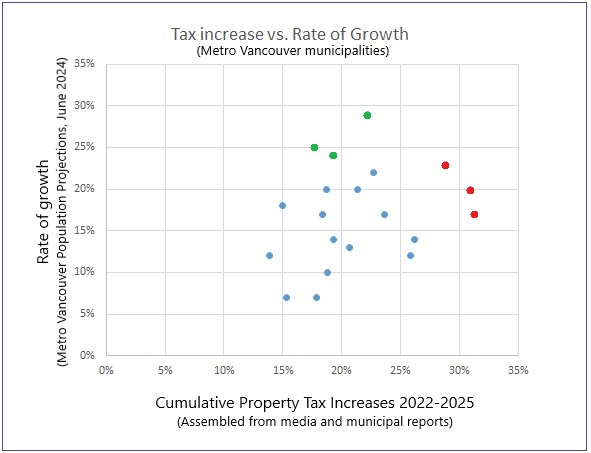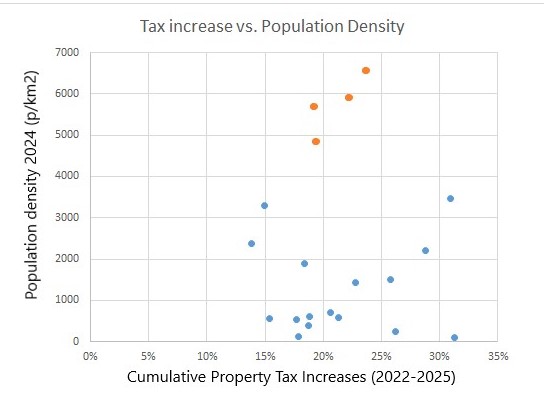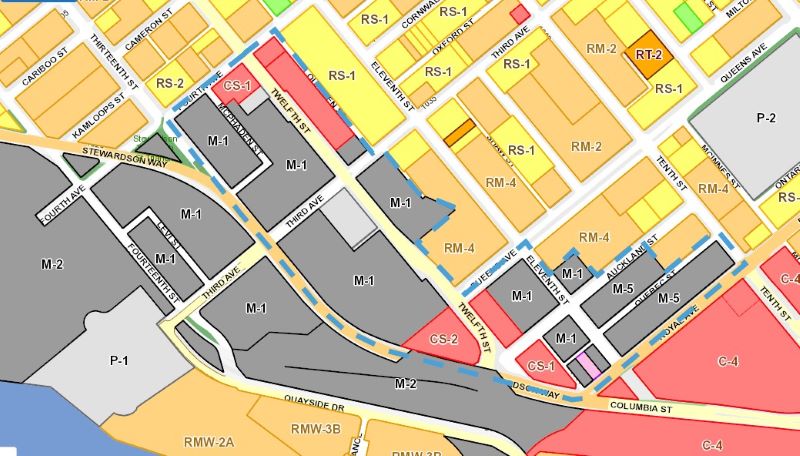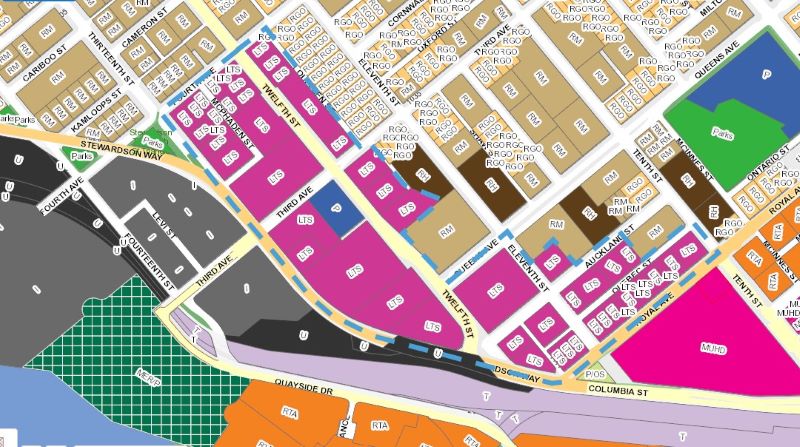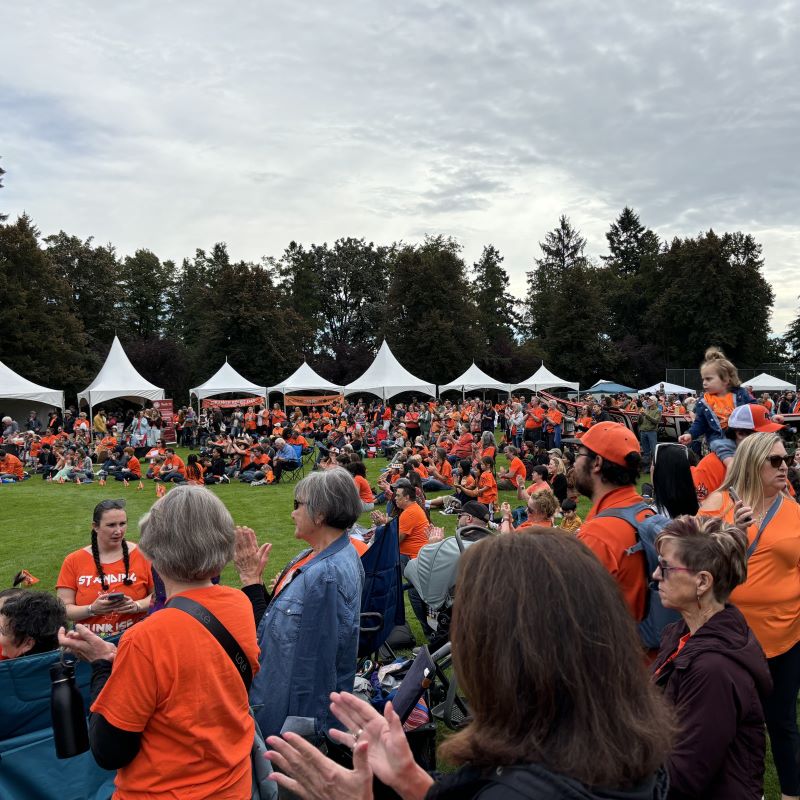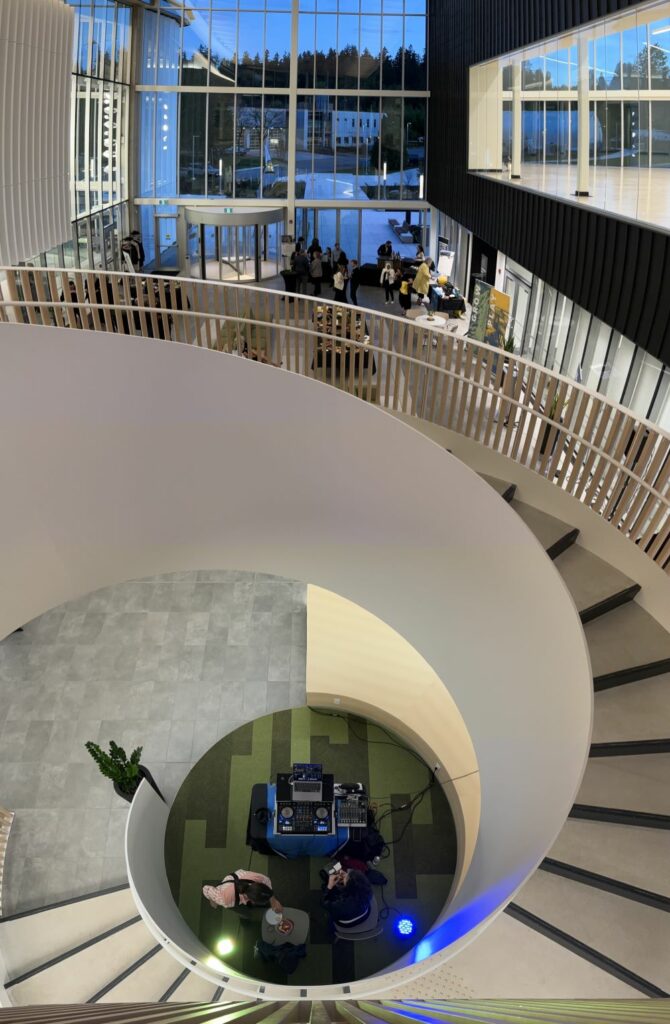We had a special meeting on Monday to decide on whether to give three readings to a rezoning bylaw for Columbia Square. This was a decision deferred from last week, where there was some robust discussion and some adaptation of the proposal rising from that discussion, so Council taking an extra week to chew on it was probably a wise move. It is also the highest-profile project since Pier West was approved back in 2017, and is the largest single development to reach this level of approval since I started on Council a decade ago, so it is worth spending some time writing out the details and addressing some of the feedback, as I did with Pier West all those years ago. The reports for Council are all here if you want to read all of the details.
Not to bury the lede, Council voted 5-2 to support the three readings. It is a slightly unusual process we are going through, so I want to be clear what that means. Voting against these three readings would effectively kill the project as proposed, though the developer could come back at a later date with a revised proposal which would be a lengthy process. Approving the three readings will launch a development planning process to determine how the objectives of the proposal will be met within the density and land use allocation included in the zoning bylaw. After that process, Council would have the option to Adopt the Bylaw (“final approval”) or reject it. This planning process will take several months or longer. In approving three readings, Council effectively said “we like where you are going here, prove you can keep all of the commitments to the community as you build”.
The details of the project are that the strip mall and parking lots on the 7.2 acre site would be replaced in a phased process. When built out, it would include up to 3,000,000 square feet of residential floor space in up to 8 towers. The existing 122,000sqft of retail space would be replaced, in a phased process so that every operating business has first right to refusal to relocate to the new spaces, starting with the major grocery store. There would also be 42,000sqft of Class A office space, a 9,500sqft non-profit childcare, and up to 12,000sqft of additional childcare. The current parking lot and strip model urban form would be replaced by towers-on-podia, with 25% of the ground space dedicated to public green space, including a 50,000sqft public square.
The housing tenure is one of the things that will be further refined though planning, but as current proposed, it would be about 3,800 residential units that meets the City’s Family Friend Housing policy n regards to two- and three-bedroom units. At minimum, 20% of the units would be Purpose Built Rental at market rates, and a minimum 20% of these would be non-market affordable housing operated by a non-for-profit at HILs rates.
One of the complicating factors here is the desire for a school site downtown. The developer is committed through this agreement to work with School District 40 to accommodate a school site on the property. For practical reasons, this would likely involve an “air space parcel” in one of the podia. However, the developer cannot commit that the School District or the Provincial Ministry of Education will agree to this model, or even if the School District will want this (as they may come up with alternate plans on a different site), so the extra 12,000sqft of childcare space on site will be delivered by the developer if the school site is not.
My reasons for voting to approve may be different than those of other members of Council, so I am only speaking for myself here. Recognizing some details we need to work out, the question before us was whether we want 3,800 homes or a car-oriented strip mall one block from a SkyTrain Station and in the centre of our Downtown. We have seen other neighbourhoods from Broadway and Commercial to Braid Station remain parking oriented because proposed development in these key transit hubs have always fallen short of perfect and ended up the enemy of good. We need homes in this region, and in this City. Our own Hosing Needs Assessment demonstrates the need for market housing that this will go a long way toward fulfilling (recognizing that it will not address as much of our non-market housing need, but more on that later).
In this project, I see that the retail is protected, not just the space, but in a phasing plan that allows the retailers and service businesses there to remain whole though redevelopment. We have a unique opportunity to secure a school site (not to mention several million dollars in School Site Acquisition Charges directed to the Provincial Government). I also see the re-imagining of 7 acres of parking lot and strip mall as vibrant public space just steps from a SkyTrain station. The project will also provide tens of millions of dollars DCC funding to upgrade the adjacent water, sewer and transportation infrastructure, including more than $10 Million in Park Land Acquisition DCC funding.
The affordable housing math on this site was always a stumbling block. With the commitment of 4% of the total residential space as true non-market affordable housing secured for 60 years, we could have between 140 and 170 units (depending on unit size and breakdown) of affordable housing on site – that is equivalent of two Móytel Lalém projects (the new Affordable Housing building across from the High School). It also includes an estimated $60 – $70 Million in Density Bonus money, the bulk of which Council has committed to land acquisition to support affordable housing development. It’s a bit “inside baseball” here, but the City is less successful than we could be at securing senior government affordable housing support simply because we don’t have a lot of City-owned land to put forward. Having access to these reserve funds as seed to new affordable housing investments could turn the table on affordable housing development in our city, and might be the best tool we have to reach our housing targets for non-market housing. This is a really important step for the most pressing need for our community, and will put New West in the driver’s seat with BC Housing and BC Builds.
I’m not satisfied waiting when housing is in such a need in our community and in the region. We can wait for a market to shift to eke out a few dozen more on-site affordable homes, but waiting does nothing to get affordable housing built now when the need is so acute, and does nothing to get the market housing we also need to get built. The region is growing, 1,000,000 new people by the 2040s, and not building high-density high-service housing nest to SkyTrain station in our Downtowns simply pushes the need out to the fringes of the Lower Mainland. It adds pressure to sprawl outside the Urban Containment Boundary, and not only erodes our farm and ecological lands at the periphery, but exacerbates our regional transportation challenges, undermines our Climate goals, and puts enormous cost pressure on our utilities and infrastructure. Homes on Skytrain is not only our OCP, it is our regional plan.
This is a big project, and many concerns were raised about it, so it only fair that I respond to the ones I heard the most. I am not going to engage in silliness like comparing this site to Revelstoke (it’s not a comparable, nor are Chetwynd or Lloydminster) or “Four World Trade Centres!”. That king of misinforming rhetoric is pure politics and best responded to in my Newsletter (subscribe here). But there are real concerns from residents that deserve response, and I can pull most from just one Facebook thread (citations removed to protect the innocent, this isn’t about punching down, it’s about addressing concerns)
“The City has no proper infrastructure to support thousands of more people! Schools, hospitals, policing, fire, and city services”
This project will provide tens of millions of dollars in DCC funds to upgrade the water sewer and transportation infrastructure around the site. There will also be upgrades to electrical and other infrastructure along with the project. There is an opportunity for a school on the site and the project will provide School Site Acquisition Charges at the maximum level permitted by Provincial Law. RCH is current in phase two of a massive expansion, more than doubling its size, but its ability to serve the community may be limited by the lack of housing for critical workers who run a hospital, this housing may help with that. Policing, Fire, and city services are primarily paid by property taxes, and the annual property taxes paid for this site will (by Councilor’s McEvoys back-of the-envelope estimate) increase by almost $5 million a year, while the cost to service high density residents in high rises is the lowest per capita.
There are many versions of “we don’t have the services to support housing” argument around the region, and in other high-growth cities from Surrey to Toronto . But there is a false math in this, the presumption that people will only come if we approve housing. The simple and measurable fact is that both this city and this region are increasing in population faster than the rate of housing growth – much faster. People are increasingly underhoused and facing terrible housing security as the vacancy rate bounces around 1% and prices spiral out of reach. Its not just that people need schools and childcare and hospitals; they need these things AND they need housing. Not building housing will not get those other things built faster. The City doesn’t build hospitals or schools, but we can be supportive and advocate for their being built (like we are right now with the RCH expansion, the expansion of the elementary schools at Queensborough, the upcoming Simcoe Park school, and our work to leverage a school site out of this project). And the people who work in those hospitals and schools are going to need homes – that is the part we are responsible for providing as Cities.
“It’s already a traffic nightmare and now you want to add even more traffic to the roads downtown new west.”
The biggest challenge we have with traffic in New Westminster is through-traffic, not residents. This project is completely in line with the regional plan (Metro2050) and Regional Transportation Plan (Transport2050), both of which emphasize building more housing on rapid transit, reducing parking requirements, and providing full-service communities to reduce the need for people to be automobile dependent. The success of those plans can be seen in New Westminster growing by 9% between the last two TransLink Trip Diary surveys, and our use of automobiles not increasing a single percent during that time. People are moving to the region, and need homes. We can choose to build high-service high-density homes near work places and near SkyTrain stations, or to build those other forms on the periphery of the region that give people no option but to drive for their daily needs. One of those two options creates more traffic. Those school and hospital workers, the people working in the retail and office spaces here in New West, if they all need to drive from Langley to get to work we have created the North Shore model of traffic congestion and harmed the livability of our city and others.
“Translink really does need a major upgrade to handle this kind of population increase, more bikelanes and greenways would be nice too”
I hear you. TransLink’s current expansion plans include a doubling the Expo Line train service and more than doubling regional bus service. It isn’t completely funded, but the Mayors Council is working hard to secure the capital investments and a secure operational funding model to meet these needs. I am confident the governments will see their way to support Transit, as it is the only real solution to getting around our growing region. Replacing a strip mall parking lot with open greenspace people can more safely walk, cycle, and preamble through will be a benefit of this project, as are the millions in Transportation DCCs this project will provide. Providing full-service neighbourhoods is why we work to leverage protection of the existing businesses and childcare out of sites like this.
“How about building more low income housing for those waiting on bc housing list? ”
This project will have between 140-170 non-market affordable homes. Saying “no” to this site right now will do nothing to add to the affordable housing stock. The biggest benefit to affordable housing will be the City’s commitment to use the bulk of the Density Bonus money to secure land and leverage senior government affordable housing investment here in New Westminster.
“What happens to all the businesses currently in Columbia Square?”
With the phasing of the project, there will be opportunity for the businesses to relocate to new spaces, starting with the large grocery store. The retail will be replaced one-for-one and the current operators will have first right of refusal on new sites.
The bigger question about businesses downtown is also relevant, as the Chamber of Commerce and the Downtown BIA provided letters of support for the project. Aside from preserving the businesses on site, it shouldn’t be hard to see that 7,000 new customers a 5 minute walk from your doorstep every day should be a good thing for customer-serving businesses? And this means more business success and variety for the rest of us to enjoy as well. A vibrant commercial community needs a local customer base.
There is general anxiety about the rate of growth, in New Westminster, in the Lower Mainland, and in Canada. I hear it. and I’ll let the economists argue the benefits of this to capitalism, but also suggest that in an increasingly uncertain post-pandemic global order of climate disruption and authoritarian uprisings, Canada will only increasingly be seen as a safe harbour of stability, and the pressure in immigration will only increase. That said, I circle back to this project being consistent with the growth envisioned in the City’s 7-year-old Official Community Plan and completely in line with the anticipated growth in our Regional Growth Strategy, with the housing need identified in our community for the decade ahead. The project as proposed gives us access to infrastructure and amenities the community wants, either directly (childcare, school site, DCC funding) or indirectly (density bonus, increased tax revenue), and is a good deal for the community.
Now that Council had given the rezoning three readings, there will be a Master Plan process that will include community and stakeholder engagement. This is where the real details of the site will be shaped, and I hope people continue to engage.
